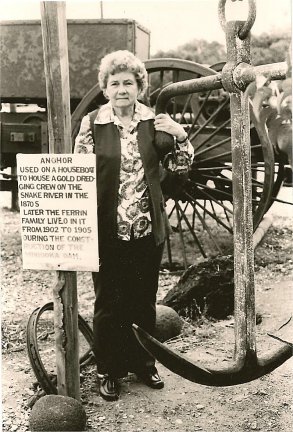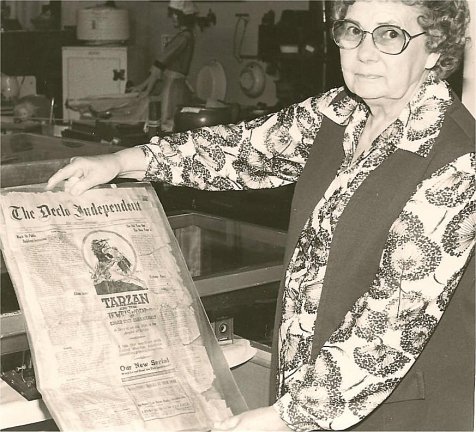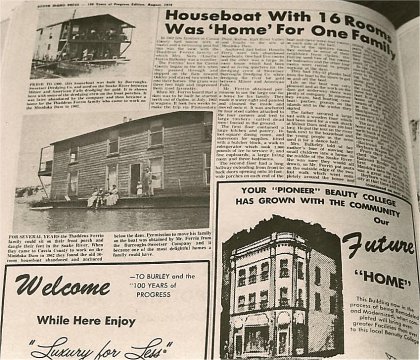
First and Only Weekly Online Fanzine Devoted to the Life & Works of Edgar Rice Burroughs
Since 1996 ~ Over 10,000 Web Pages in Archive
presents
Volume 2171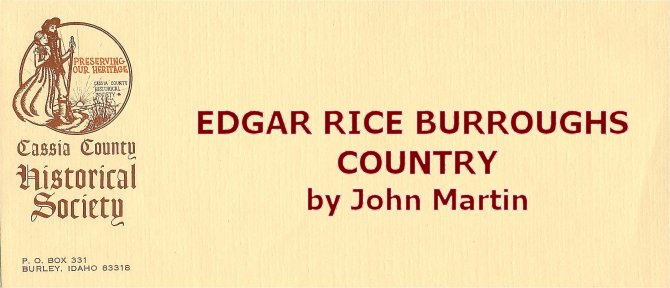
Part II
Idaho is Edgar Rice Burroughs Country
Continued from Part I in ERBzine 2170Idaho is one of those "panhandle states," like Oklahoma and, some say, Texas. I don't know, though. You'd have to have an awfully large hand to get it around that Texas-size panhandle, but Oklahoma and Idaho's versions are just about right. Oklahoma is a panhandle state with the pan positioned ready to go on the stove. In fact, it looks like it's been on the stove too long and the bottom is melting. Idaho has the panhandle sticking straight up, as if the pan were still hanging on the wall.
On my trip through Edgar Rice Burroughs Country, I passed through the northern part of the state as I headed east and shot across the panhandle in the middle of the night. Well, not quite all night. We got tired around 11:30 and found a rustic motel in Wallace that still had a vacancy. Instead of having numbers, these rooms were distinguished by the names of western pioneers and gold rush-related terms. We stayed in the Wyatt Earp unit and the bed seemed like it had been around since Wyatt's day. The bed made it real easy to rise early and get on the road again so that we were rolling into Montana in time for breakfast in Superior.
On the way back west, our route took us through the lower part of the state. It was there I expected to find Edgar Rice Burroughs Country, and I was not disappointed.
The Burroughs fans' guidebook to Idaho is Edgar Rice Burroughs: The Man Who Created Tarzan, by Irwin Porges, BYU Press. This volume sits in almost every Burroughs fan's library. Most of my background information in this article comes from Porges' book. There's also some information about Burroughs' Idaho days in Edgar Rice Burroughs: Master of Adventure by Richard Lupoff, and The Big Swingers by Robert Fenton (recently reprinted and revised by George T. McWhorter, University of Louisville, as ERB and TARZAN: A Biography. See ERBzine Swag). I know that there have been articles in some of the older fanzines about Idaho, too, but I don't have any of these. If anyone does, and cares to send me photocopies of the appropriate pages, I'd love to have the information in case I go to Idaho again.
One of the great things about ECOF '89 in Tarzana was being able to walk in the same places where Edgar Rice Burroughs walked. There's nothing magical or mystical about it -- it's just plain interesting to see those places and to try to imagine what it may have been like when Burroughs himself lived there, and to wonder what thoughts may have gone through his head as he lived in those places.
And so, I determined to go through Edgar Rice Burroughs Country to share what little I could of the experiences he had. But I was also curious about what there was today in Idaho to remind people that this famous author had once lived in their midst. Would there be monuments to him (Edgar Rice Burroughs slept here)? Did the museums have displays about him? Did libraries and bookstores keep his novels available? Did local newspapers have files full of articles by and about him?
I didn't have the time to find the answers to all of these questions (so there are still plenty of things to be found out by fans who visit Idaho in the future!) But I did find ample to keep me busy and happy.
Edgar Rice Burroughs spent three approximate two-year periods of his life in Idaho. In 1890 and 1891, he worked as a lad of 16 on his brothers' ranch in the Raft River Valley. He returned in 1898-99 and ran a store in Pocatello, then later worked again on his brothers' ranch. During 1903 and 1904, it was Mr. and Mrs. Burroughs who lived in the Stanley Basin of Idaho's Sawtooth Mountains and later in Parma, Idaho. In 1904, Burroughs left Idaho for the last time, to take a job as a railroad policeman in Utah.
We would be visiting his haunts in geographical order, so the first leg of our journey would take us to the locale of Burroughs' second stay: Pocatello.
We left Yellowstone National Park in Wyoming and came out in the tourist town of West Yellowstone, Montana, where we killed about an hour. Then it was out of Montana via Highway 30 and down to its connection in Idaho with Interstate 15, which brought us into Pocatello.
Pocatello is a well-kept, attractive town that is easy for a stranger to find one's way about in. I simply followed signs pointing the way to "city center" and eventually found myself in what is known as the "Downtown Historic District" and also found myself on the very avenue, Center Street, which Porges lists as the locale of the book and stationery store Burroughs ran.
Porges gave only a street and a not a number, however, so I just looked around for some clue. One of the first things I spotted was a sign in an office window which said something about "downtown historical association." We went in and a lady at a desk was talking with a man. I noticed some historical pamphlets on the floor and squatted down and started looking through them. Finally, the man left and the lady sought to help us.
I introduced myself as the publisher of a Burroughs "newsletter" (I thought that would be easier for people to understand than "fanzine"). I explained I was doing some research for a future edition and was seeking the location of Burroughs' store. This lady was not aware that the creator of Tarzan had once lived in her town, but she was very interested to hear it. She directed us to the Bannock County Museum, which she said might be of more help.
My wife, meanwhile, had noticed a title company next door and, being a former realtor, knew it would have records that would show any ownership changes in the buildings. Thinking they might have records that would produce an address, she checked out the title company while I wandered over a two-block area, looking for more clues. I talked to one man in an antique store who had never known Burroughs was in town either. Later, when I found the location, I went back and told him it was across the street from him.
Peggy's inquiry at the title company bore fruit, but only in a negative way. The records showed no real estate transactions between a Mr. Burroughs and a Mr. Roeder. So, Burroughs had never bought the building; only the business. No help in finding a street address.
We left the downtown area and drove to the Bannock County Museum again an easy place to find. Actually, one can follow the signs that point the way to the county Natural History Museum for awhile. But after passing that museum one must continue on for a ways to come to the Historical Museum.
The Bannock County Museum is in a newer building next to a replica of old Ft. Hall. We explained our mission to the museum director, Mary Lien, and were greeted warmly and enthusiastically. Mrs. Lien knew all about Edgar Rice Burroughs and she invited us to see a display she had. Now, this display was in storage at the time (no museum has enough room to keep everything on display all the time) but Mrs. Lien was happy to unpack it for us. It consisted of several large, newspaper page-size display boards, each with several large black and white photos and detailed captions, showing Burroughs' life and works. Many of the pictures are ones identical to those found in Porges' biography, showing Burroughs in his early Idaho days. Other photos are from later events in his life and some are of movie Tarzans. this display had been used earlier and no doubt will be on display again from time to time. It was the best pure Burroughs display I was to find in Idaho.
Mrs. Lien was able to give us the exact address -- 233 West Center Street -- of Burroughs' store and also had pictures to help us find the way.
There was no picture of how the store looked when it ws in Burroughs' hands, but we were provided with pictures of the building before and after his tenure.
Armed with the address and picture photocopies, I was able to go back to the Pocatello Historic District and capture the exact location on film. A 233 address would normally indicate a location in the middle of a block but, in this case, a corner location is accurate. The original building is long since gone and the site is partially occupied today by a brick building and, on the corner itself, by landscaping and a tall tree.
It seems appropriate that, just as a large tree marks the entrance to Burroughs' Tarzana, California, headquarters, so too a tree stands in the very spot where he once operated his store.
The next morning we headed west across Idaho, looking for the Raft River Valley, where young Ed Burroughs worked as a ranch hand at the age of 16. The route from Pocatello is known as I-15W on my older folding map but my new atlas and the road signs agree that it is now I-86. It eventually blends in with I-84. Porges' book says Ed rode the 30 miles from the ranch to American Falls on the mail run each day, and indeed the Raft River Valley is 30 miles down the road, which indicates that the ranch must have been very near to where the freeway exit is today.
Raft RiverAs we approached our destination, I saw freeway signs that I thought were a bit unusual. They didn't say "Raft River" or even "Raft River Valley," but they said "Raft River Area." I wondered why the term "area" was used and eventually figured it out.
We got off the freeway at the Raft River, but we went left and under the freeway. The road went straight (south) but there was a side road leading to the Raft River store.
I decided to take the straight ahead road first and, although I didn't see a sign right there, I found one later which identified the thoroughfare as "Yale Road." Ed's brothers, George and Harry, had teamed up with Lew Sweetser to develop the ranch on land owned by cattle baron Jim Pierce. "To honor their alma mater the brothers called their ranch the Bar Y . . . and paid further tribute to their college by naming the post office Yale." (Porges, p. 18) If the Yale Post Office is still around, I didn't see it. But at least the road is still there.
Just a short distance down the road was a dirt ranch road taking off to the right and leading over a low distant hill. Even though there were "No Trespassing" signs along that road, I would just about have gone down it anyway to find out if there was a ranch there and to ask the inhabitants if they knew it was the former Burroughs spread. But time considerations and our continuing car problem kept me from making this little side trip into unknown territory.
Our car would start and drive okay but its problem was that it wanted to die when I was slowing down or braking, such as on freeway off-ramps and city intersections. It was a heavy car and when the engine died so did the power steering and brakes. Because my wife has arm and back trouble, I was stuck being the sole driver as she wouldn't have been able to handle it if it'd done that on her. In addition, it was losing power on hills, sometimes slowing down to 35 miles per hour with the gas pedal floored (even at 35, we managed to keep ahead of the tractor trailer rigs on those hills!). So it was a nuisance to drive, but it was indeed driveable and we planned to nurse it home and have it fixed there rather than spend two or three days of our vacation sitting in a motel and waiting for some unknown mechanic to fix it for us!
But I continued down the main road instead; as we drove along, I could see the lush green meadows to our right, contrasting with the barren brown hills in the background. The land was watered by lots of sprinklers which seemed to sprout in many places. I was anxious to find a bridge over the Raft River itself because one of the things I wanted to do was to get a picture of Burroughs' river. But as we drove on and on, I wasn't finding it.
There were some things to see, though. Along the way a couple of horses strolled leisurely alongside a fence line. One could almost picture a teen-age Ed astride one of the beasts, as he had done so often 100 years ago.
Ed liked black horses. Porges (page 21) tells of one named Whisky Jack, a gelding "fat as butter, with a long mane and a tail that almost dragged the ground." The horse was ornery and had already killed one man but Ed was determined to ride it. On his first attempt, the horse fell with Ed beneath him. On the second try, Ed rode around on the horse all day, afraid to get off for fear he couldn't get back on. There were other adventures with Whiskey Jack, but he remained Ed's horse.
A few years later, on his second trip to Idaho, Ed rode a black horse named Crow in the ranch area and he told (Porges, p. 73) of a time when a pack of either wolves, coyotes or maybe just wild vicious dogs were stalking him and the mount.
Another horse he enjoyed was named Calamity (Fenton, p. 13). In The Big Swingers, Burroughs recalled "never having been as happy or cheerful as during the short time when I did hard chores, grubbed sage brush and drove a team of broncs to a sulky plough."
The Yale Road eventually made a sweeping turn to the west and still I had not crossed a bridge proclaiming the presence of the Raft River. But next up were some cattle, those in the foreground, typically, standing and staring at these intruders who were driving by. Across the road was a cattle-loading ramp. Except for modern fencing, these cattle scenes might well have been the same now as in Burroughs' day. For a biography in the June 1941 issue of "Amazing Stories" he wrote:
"Somewhere along the line I went to Idaho and punched cows. I greatly enjoyed the experience, as there were not bathtubs in Idaho at that time. I recall having gone as long as three weeks when on a round-up without taking off my boots and Stetson. I wore Mexican spurs inlaid with silver; they had enormous rowels and were equipped with dumbbells. When I walked across a floor, rowels dragged behind and the dumbbells clattered; you could have heard me coming for a city block. Boy! was I proud!" (Lupoff, p. 8)
We continued along the Yale Road until it brought us to Interstate 84, which we followed north until it brought us back to I-86. There we turned right (east) and went back to the Raft River interchange (map). We had come full circle.
We still had not crossed a river, so this time I pulled in to the Raft River Store to make inquiries. The sign outside said there was a new owner, who turned out to be Sharlene Lavender. She told me there was a simple reason why I couldn't find the river: It no longer exists! The river was dammed years ago before, she explained, when the primary use of the area changed form ranching to farming. The many sprinklers that I saw use water from the restrained river. Thus, the water still flows, in a sense, but differently than in Burroughs' day.
I did cross one bridge near the store, but it covered something so small that I didn't bother to take a picture. It is likely all that is left of the river path itself. Hence the term: Raft River "Area."
In time past, the river was more formidable. The Oregon Trail crossed the river near the Raft River Store and the river got its name from the fact that wagons had to be loaded onto rafts to get them across the waterway. Sharlene told us that a group retracing the Old Oregon Trail had come through the area recently and camped near her store.
At the time he rode these ranges, young Ed was not yet a writer, but when he did become one in later years he did not forget this region of the country and, in fact, used characters and locales from this area in his tories.
One of these stories, Minidoka, 937th Earl of One Mile, Series M, remained unpublished in Burroughs' lifetime but was released in recent years by Dark Horse (1998); its locales include the Raft River.
MinidokaERBapa member Bob Barrett had the privilege of reading the manuscript for this story when he visited Tarzana, California, for the ECOF gathering in the summer of '89. Bob provided a synopsis of the story along with a review in an article ERBANIA No. 61, Spring 1990.
The name of the story's hero, Minidoka, is of course, the name of both a town and a county which borders Cassia County, site of the Raft River Valley.
I asked Bob for some more information about the story, as pertains to Idaho, and he recalled: "There were two warring kingdoms (not families), the Bradydom of Smith and the Connerdom of Bil. The Connerdom of Bil was directly south of Basalt, the land of Brady Pzvrtjhk. The principal boundaries of these two countries (was) separated by the Raft River. To the north of the Snake River and west of the Raft stretched Basalt.
"The Land of Bil was bounded by the Snake River and reached all the way down to Salt Lake (which was much bigger in those days!).
"It also mentions the old Oregon Trail, where it crosses the modern Raft River at the old Bowers Ranch, near Yale in Cassia County as being where Minidoka stopped the flow of lava at the edge of his Connerdom, the lava having come from the power of the Spring of Fire which Minidoka unleashed to destroy the Bradydom of Smith," Barrett said.
Burroughs, as the narrator, also "mentions the digging going on in the Raft River 'today' (1904!) for gold -- to recover the "fine pieces filed off during the construction of the Golden Palace of Pzvrtjhk and dumped in the river to be gotten rid of."
In addition to Minidoka, Idaho references are to be found in some of Burroughs' other published books.
Burroughs, in recalling his Cassia County days, remembered an old man named Blanco who "stammered terribly and cursed like a pirate." In The Mucker, Burroughs wrote of a pirate named Blanco.
On the ranch were a cook named Hank Monk and a cowpuncher called Sam Lands. A "Hank" shows up on Wichita Billings' ranch in The War Chief and we meet a "Sam" in the same place in Apache Devil."
But The Bandit of Hell's Bend takes first prize for the best transfer of Idaho realism into Burroughs fiction. The locale is different -- Arizona instead of Idaho -- but there's a character in the book called Idaho, who is a ranch hand at, what else, the Bar Y ranch.
One of the more colorful characters in BHB was Texas Pete, the balladeer. He was based on real-life Texas Pete who ranched with Burroughs. The real Texas Pete, alas, was killed by a sheriff's bullet when attempting to row across the Snake River to avoid prosecution for a minor offense (Porges, p. 22-23).
Burroughs also remembered a Cassia County character named Gum Brown, the sheriff. "Whenever anyone had to be arrested or a posse was formed, Gum would go around the saloon and point to the cowboys saying, 'I deputize yo': I deputize yo'", and nobody would pay any attention to him. It was a standing joke in Albion," Burroughs said (Porges, p. 23).
Burroughs never forgot that. And, when Bandit was published in 1925, it contained this passage, with Sheriff Gum Smith an obvious copy of Gum Brown:
"Yo all's undah arrest," he piped in a high, thin voice, and turning toward the men seated about the neighboring tables he pointed first at one and then at another. "Ah depatize yo! Ah depatize yo! Ah depatize yo!" he announced to each as he covered them in turn with his swiftly moving index finger. "Seize him, men!" No one moved. Gum Smith waxed excited. "Seize him, yo' - all! Ah'm sheriff o' this yere county. Ef Ah depatize yo' - all yo'all's got to be depatized." (BHB, Chapter 1)
Another Burroughs book, Snake River Cotton-Tail Tales, reflects Idaho memories in its title, at least. The book, a hand-done 12-pager with light verse and drawings by Burroughs, was "published" in a very limited edition of one copy for his niece Evelyn.
As for Ed's enchantment with the name of Minidoka, it probably stuck in his mind mostly because his brothers began operating a gold-mining dredge on the Snake River near there after they gave up on the ranching business. The gold-mining efforts were no doubt also responsible for some of the mentions of the Snake River gold in the Minidoka yarn.
Minidoka is in Minidoka County, a county separated from its neighbor, Cassia County, by Interstate 84. The largest city in Minidoka County is Rupert, a town of about 5,500. Minidoka is about 11 miles north of Rupert on a road which is straight as an arrow but crooked horizontally. When we got there I had to drive around the town (about 16 square blocks) a couple of times to figure out that I was really there, because there were no signs saying "Welcome to Minidoka," or the like. Even the U.S. Post Office, the only public building in town, simply called itself "Post Office" on its sign and listed a zip code. My wife went into the post office to confirm this was indeed Minidoka, while I turned my attention to the sign on the building across the street, and took its picture my only picture of Minidoka.
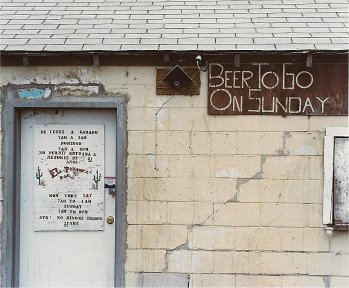
Minidoka is not much of a town. This sign is one of the more interesting sights.
Whether itís an old sign or whether the offer is still good, I couldnít tell (I was there on a weekday!).I did attempt to speak to one resident. He was walking down the street near a building that appeared to be a store, and I pulled up and asked him if this was Minidoka. "No speaka English," he replied.
Minidoka had a more dubious claim to fame during World War II. It was the sight of one of the camps in which the U. S. government interned Japanese Americans.
Between Rupert and the freeway is the Minidoka County Museum, a building which is easy to find since signs from the freeway direct the traveler along the only road there is.
The people of Idaho are very proud of their heritage and we found museums wherever we looked for them. One of the most interesting exhibits in this museum was a long wicker basket used in the olden days by morticians.
There were photos on Burroughs activities in the area, but not on Edgar Rice. The museum has several boards with mounted photos which include pictures of the Burroughs-Sweetser dredging operations which took place nearby.
A scrapbook contains a newspaper clipping of a photo of the two-story Burroughs houseboat which the dredging family lived in. The same photo is on page 80 of Porges' book with the caption "El Nido (the nest), houseboat built by partners in gold-dredging adventure."
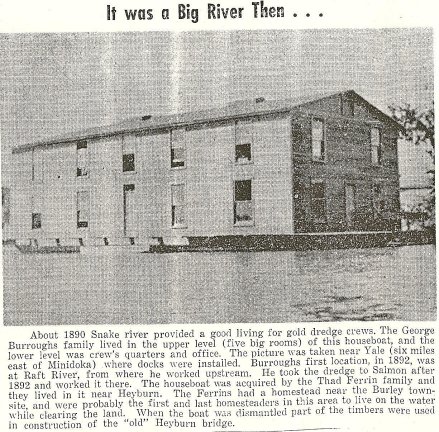
Clipping of a photo, showing the Burroughs family houseboat,
is in a scrapbook at the Minidoka County Museum, IdahoThe caption for the same picture in the museum's scrapbook was a bit longer. Headed: "It was a Big River Then . . ."the caption reads: "About 1890 Snake River provided a good living for gold dredge crews. The George Burroughs family lived in the upper level (five big rooms) of this houseboat, and the lower level was crew's quarters and office. The picture was taken near Yale where docks were installed. Burroughs' first location, in 1892, was at Raft River, from where he worked upstream. He took the dredge to Salmon after 1892 and worked it there. The houseboat was acquired by the Thad Ferrin family and they lived in it near Heyburn. When the boat was dismantled, part of the timbers were used in construction of the "old" Heyburn bridge.
While I said the best "pure Burroughs" display I found in Idaho was at the Bannock County Museum in Pocatello, I have to give the Cassia County Museum in Burley credit for having the most Burroughs "treasures."
Burley
Burley is about the same size as Rupert only it's south of Rupert and south of I-84 and in the county next door.
The museum is on Main Street and easy to find, next to the fairgrounds.
This museum features a huge relief map of Cassia County which, we learn by playing a tape, is the only country in the U.S. crossed by five pioneer trails. The map lights up to show the trail routes as the short tape plays.
While my wife roamed the exhibits, I stepped into the office of Rachel Martindale, museum curator, to examine some scrapbooks and special historical editions of area newspapers. I hadn't turned too many pages when I made a delightful find: There was an article recalling the fact that "Tarzan of the Apes" had played at the Burley Theatre. The writer of that old article probably didn't know that Tarzan's creator was once a resident of Cassia County, or it likely would have been mentioned. (See Tarzan Battled Cannibals in '18 Cinema Thriller)
How could residents sit at home in 1918 when the year's absolute sensation "Tarzan of the Apes" was playing at the Burley Theatre. 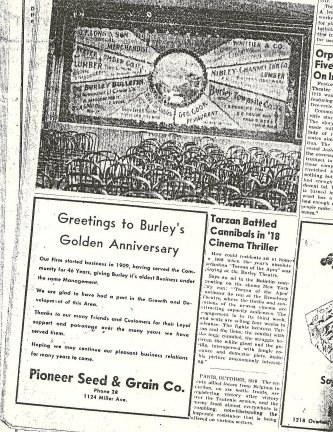
Tarzan Battled Cannibals in '18 Cinema ThrillerSays an ad in the Bulletin commenting on the shows New York City run: "'Tarzan of the Apes' continues its run at the Broadway Theatre, where the thrills and sensations of the newest cinema are attracting capacity audiences. The engagement is in its third week, and seats are selling four weeks in advance. The fights between Tarzan and the lions; the combat with the huge cannibal, the struggle between the white giant and the gorilla, interspersed with jungle romance and domestic plots, make this picture uncommonly interesting."
But my wife gets credit for the best find -- a January 2, 1920 ad for the serialization of Tarzan and the Jewels of Opar in the Declo Independent. When young Ed roamed the towns of Albion and Declo and others in Cassia County, it would probably have stunned him to know that some years later the local newspapers would serialize one of his stories. The Declo newspaper has long ago gone out of business. I wonder how many other newspapers serialized Burroughs stories and are still waiting to be discovered?
My wife found this in a Declo-oriented display case. Oddly, it wasn't there because of the Tarzan ad, but simply because it was an old Declo paper. Perhaps future visitors to the museum will find a notation on the newspaper saying that the author once lived in Cassia County!
Another great treasure at the Burley museum is shown off by Mrs. Martindale in the accompanying photo. It is the anchor from the two-story houseboat owned and lived in by the Burroughs families and later by others. The placard next to the anchor doesn't mention the Burroughs family, oddly enough, but does refer to a family which lived in it after them. The placard says: "Anchor used on a houseboat to house a gold-dredging crew in the 1870s. Later the Ferrin family lived in it from 1902 to 1905 during the construction of the Minidoka dam."
That conflicts somewhat with Porges (p. 81), who says the Burroughs brothers themselves built the houseboat, beginning in 1899 -- not the 1870s. But we'll leave it to someone else to resolve that problem.
Below are examples from historical newspapers. At left is a photo of Burroughs dredge. A similar photo, from the opposite side is in Porges' book (p. 81). At right is an article on the Ferrin family, which moved into the houseboat when the Burroughs family moved out.
.
Shortly after returning to Chicago from his second sojourn in Idaho, Ed married Emma Hulbert. So it was Mr. and Mrs. Burroughs who made that last trip to Idaho in 1903.
Just getting there proved an adventure, as they determined to bring along their pet collie, Rajah, even though dogs were allowed to ride only at the whim of train officials. In his autobiography, Burroughs said he brought lubricant, in the form of "the ingredients for numerous cocktails," to make sure the wheels of officialdom turned smoothly. (Porges, p. 85)
"Raja," minus the "h," became another real-life being to turn up in Burroughs' books. In Pellucidar, inner world adventurer David Innes gives his prehistoric hyaenodon pet that name. "I saw only the sad eyes that looked like the eyes of Raja, my dead collie of the outer world." (Pellucidar, ch. 7)
Ed and Emma first went to Mackay and then to the Stanley Basin in Idaho's Sawtooth Mountains, to work with his brothers in gold-dredging operations on the Salmon River.
"Ed and Emma pitched a tent on a hill while he built a cabin, 'the construction of which was original and not too successful but timber was plentiful and I felled what I needed at no great distance from our cabin site.'" (Fenton, p. 33)
The adventure proved short-lived, however, and soon Ed and Emma moved to Parma, Idaho, where the Burroughs family also had a gold-seeking effort.
Pocatello, Raft River, Minidoka are all within easy driving distance of each other but this next and last stop on our Edgar Rice Burroughs Trail would require about 180 miles of travel, as Parma sits on the west end of the state within sight of Oregon.
To get to Parma we had to turn off I-84 and travel down secondary highways. This proved to be quite an adventure, as both the highway into and out of Parma were torn up with road construction at the time of our visit.
On the way into town we passed the Fort Boise replica, which had a statue of a Tarzan-like figure out front.
My first stop was the office of the town newspaper, the Parma Review. I talked to Connie Landman, editor. I told her I was interested in knowing which buildings in town were standing back in the early 1900s, when Burroughs was there. She told me the newspaper office itself was such a building. I also asked her if she had newspapers going back to April 1904, when Burroughs won election as a Trustee of the Village of Parma. She looked through her stack of bound volumes of back issues, but strangely the one with that month was missing. I hope it was merely temporarily misplaced and not appropriated by an over-eager Burroughs fan at sometime past.
Connie pointed me to the town historian, Lucille Peterson, and even telephoned Mrs. Peterson and told her we'd be dropping by. The directions were easy to follow and soon we were knocking at her door. Mrs. Peterson was taking care of her granddaughter that day and my wife played with the child while I asked Mrs. Peterson about Mr. Burroughs.
Mrs. Peterson, along with Helen Lowell, is author of a book, Our First Hundred Years - A Biography of Lower Boise Valley - 1814-1914.
Of course, in an area history one couldn't expect to find very much about a man who was only a temporary resident, and so just one paragraph is devoted to Edgar Rice Burroughs, but it pretty well sums up the salient points. It reads:
"However, belief in the presence of gold dies hard. Besides big operations, several small concerns dredged at different times. In 1905-06, the Sweetser-Burroughs Mining Co. installed a dredge on the Snake near the mouth of the Boise. One member of the company, George Burroughs, moved his family to Parma where his children Studley and Evelyn, attended school that winter. On weekends they were visited by their uncle Edgar Rice Burroughs who worked with his brother on the dredge. At the time of his death in 1950, Edgar Rice Burroughs' wealth was estimated at $15 million, but it came from his Tarzan creations, not from mining on the Snake."
Of course, there seem to be some discrepancies in this account and the one in Porges' biography. The dates are different, and Porges says Harry is the brother who lived in Parma (although probably both lived there). I'll let someone else puzzle out the differences!
At any rate, Mrs. Peterson, a charming lady, recalls that her husband, Elmo, was in love with George Burroughs' daughter when he was in the fourth grade.
Porges tells how Burroughs won election to the board of trustees of the Village of Parma. "Ed had run as an independent . . . but still managed to secure enough votes to edge his way in." How did this newcomer to Parma edge out his closest competitor by one vote? Burroughs, perhaps with tongue somewhat in cheek, recalled: "I button-holed every voter that I met, told him that I was running for office and that I did not want to be embarrassed by not getting a single vote and asking him as a personal favor to cast his vote for me, with the result that enough of them tried to save me from embarrassment to cause my election." (Porges, p. 89)
Mrs. Peterson agreed that Burroughs' decision to run as an independent was probably "how he got the vote." Parma, she said, used to be an intensely political town, with two competing newspapers, one Democrat and one Republican. An independent offered an extra choice to members of both parties.
I sent Mrs. Peterson some more background information on Edgar Rice Burroughs and she says she will send me a copy if she writes another historical article about him in the town newspaper. If that happens, I'll share the story in a future article.
Another stop in Parma was at the city hall, where I met the mayor of 18 years, Patricia Romanko. She knew who Edgar Rice Burroughs was, because her children read her books.
I asked the folks at the city hall if they had meeting minutes from the time when Edgar Rice Burroughs was on the town board. I thought it would be interesting to see what mention they made of him, how he voted on town issues, etc. But record-keeping must have been lax in those early days, either that or the records have disappeared, because they aren't there now.
While my wife became intrigued by a garage sale across from the city hall, Mayor Romanko took me in her car down to the Ft. Boise replica, which also served as the town's museum. The museum was locked at this time, as they have trouble getting someone to staff it full-time on a volunteer basis, but Mrs. Romanko, of course, had the key!
I found that the Tarzan-like statue outside the fort/museum was of a character named Bigfoot who had terrorized the countryside back in the old days before being killed and becoming, after his death, even more of a legend.
We checked several display cases in the museum, but there was nothing there concerning Burroughs.
Burroughs served with the Parma town government only a short time. Then, he moved on to Utah for a job as a railroad policeman. But I didn't follow the trail to Utah; it was time to go home.
I had fun in Edgar Rice Burroughs Country. But I didn't have near enough time to do all that could have been done. I visited one library, and there are many more. I visited one newspaper office, and there are many more. What newspaper articles have been written over the years in Idaho newspapers about Burroughs? What do their files hold? Burroughs even wrote poems for and placed ads in the Pocatello newspaper. Porges reports on them. Are there more to be discovered?
I never went to visit Albion, the home of Sheriff Gum. And there must be more museums I didn't find.
In short, there's a lot more to dig out in Edgar Rice Burroughs Country. Burroughs and his brothers didn't get all the gold, and I didn't get all the information in this one short trip.
The roads are good (for the most part), the people are friendly, the cities are clean. Idaho is a nice place to take a family (after all Burroughs went there three times!).
It would be a great place to have a convention of Burroughs fans.
It would be a great place to take a vacation.
Do it. Go to Idaho. Go to Edgar Rice Burroughs Country.
Continued in Part III: ERBzine 2172
